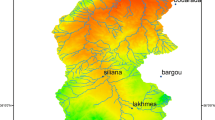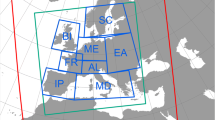Abstract
The multi-model ensemble mean is generally used as a default approach to estimate climate change signals, based on the implicit hypothesis that all models provide equally credible projections. As this hypothesis is unlikely to be true, it is in theory possible to obtain more realistic projections by giving more weight to more realistic models according to a relevant metric, if such a metric exists. This alternative approach however raises many methodological issues. In this study, a methodological framework based on a perfect model approach is described. It is intended to provide some useful elements of answer to these methodological issues. The basic idea is to take a random climate model and treat it as if it were the truth (or “synthetic observations”). Then, all the other members from the multi-model ensemble are used to derive thanks to a metric-based approach a posterior estimate of the future change, based on the synthetic observation of the metric. This posterior estimate can be compared to the synthetic observation of future change to evaluate the skill of the approach. This general framework is applied to future summer temperature change in France. A process-based metric, related to cloud-temperature interactions is tested, with different simple statistical methods to combine multiple model results (e.g. weighted average, model selection, regression.) Except in presence of large observational errors in the metric, metric-based methods using the metric related to cloud temperature interactions generally lead to large reductions of errors compared to the ensemble mean, but the sensitivity to methodological choices is important .







Similar content being viewed by others
References
Annan JD, Hargreaves JC (2010) Reliability of the CMIP3 ensemble. Geophys Res Lett 37:L02703
Annan JD, Hargreaves JC (2011) Understanding the CMIP3 multimodel ensemble. J Clim 24:4529–4538
Boé J, Terray L (2008) Uncertainties in summer evapotranspiration changes over Europe and implications for regional climate change. Geophys Res Lett 35:L05702
Boé J, Terray L (2014) Land-sea contrast, soil–atmosphere interactions and cloud–temperature interactions: interplays and roles in future summer European climate change. Clim Dyn 42(3–4):683–699
Boé J, Hall A, Qu X (2009) September sea-ice cover in the Arctic Ocean projected to vanish by 2100. Nat Geosci 2:341–343
Bracegirdle TJ, Stephenson DB (2012) More precise predictions of future polar winter warming estimated by multi-model ensemble regression. Clim Dyn 39:2805–2821
Caldwell PM, Bretherton CS, Zelinka MD, Klein SA, Santer BD, Sanderson BM (2014) Statistical significance of climate sensitivity predictors obtained by data mining. Geophys Res Lett 41:1803–1808
Collins M, Chandler RE, Cox PM, Huthnance JM, Rougier J, Stephenson DB (2012) Quantifying future climate change. Nat Clim Change 2:403–409
Déqué M, Somot S, Sanchez-Gomez E, Goodess CM, Jacob D, Lenderink G, Christensen OB (2012) The spread amongst ENSEMBLES regional scenarios: regional climate models, driving general circulation models and interannual variability. Clim Dyn 38:951–964
Giorgi F, Mearns LO (2002) Calculation of average, uncertainty range, and reliability of regional climate changes from AOGCM simulations via the Reliability Ensemble Averaging (REA) method. J Clim 15:1141–1158
Gleckler PJ, Taylor KE, Doutriaux C (2008) Performance metrics for climate models. J Geophys Res 13:D06104
Hagedorn R, Doblas-Reyes FJ, Palmer TN (2005) The rationale behind the success of multi-model ensembles in seasonal forecasting—part I: basic concept. Tellus A 57:219–233
Hall A, Qu X (2006) Using the current seasonal cycle to constrain snow albedo feedback in future climate change. Geophys Res Lett 33:L03502
Jun M, Knutti R, Nychka D (2008) Spatial analysis to quantify numerical model bias and dependence: How many climate models are there? J Am Stat Assoc 103(483):934–947
Knutti R, Meehl GA, Allen MR, Stainforth DA (2008) Constraining climate sensitivity from the seasonal cycle in surface temperature. J Clim 19:4224–4233
Knutti R, Furrer R, Tebaldi C, Cermak J, Meehl GA (2010) Challenges in combining projections from multiple climate models. J Climate 23:2739–2758
Knutti R, Masson D, Gettelman A (2013) Climate model genealogy: generation CMIP5 and how we got there. Geophys Res Lett 40:1194–1199
Lambert SJ, Boer GJ (2001) CMIP1 evaluation and intercomparison of coupled climate models. Clim Dyn 17:83–106
Lenderink G (2010) Exploring metrics of extreme daily precipitation in a large ensemble of regional climate model simulations. Clim Res 44:151–166
Masson D, Knutti R (2011) Climate model genealogy. Geophys Res Lett 38:L08703
Masson D, Knutti R (2013) Predictor screening, calibration, and observational constraints in climate model ensembles: an illustration using climate sensitivity. J Clim 26:887–898
Meehl GA et al (2007) Climate Change 2007: the physical science basis. Contribution of Working Group I to the fourth assessment report of the intergovernmental panel on climate change. In: Solomon S et al (eds) Climate Change 2007: the physical science basis. Cambridge University Press, Cambridge
Meehl GA et al (2013) Climate change projections in CESM1(CAM5) compared to CCSM4. J Clim 26:6287–6308
Meinshausen M, Smith SJ, Calvin KV, Daniel JS, Kainuma M, Lamarque JF, Matsumoto K, Montzka SA, Raper SCB, Riahi K, Thomson AM, Velders GJM, van Vuuren D (2011) The RCP greenhouse gas concentrations and their extension from 1765 to 2300. Clim Change. doi:10.1007/s10584-011-0156-z
Min S-K, Hense A (2006) A bayesian assessment of climate change using multimodel ensembles. Part I: global mean surface temperature. J Clim 19:3237–3256
Räisänen J, Palmer T (2001) A probability and decision-model analysis of a multimodel ensemble of climate change simulations. J Clim 14(15):3212–3226
Räisänen J, Ruokolainen L, Ylhäisi JS (2010) Weighting of model results for improving best estimates of climate change. Clim Dyn 35:407–422
Räisänen J, Ylhäisi JS (2012) Can model weighting improve probabilistic projections of climate change? Clim Dyn 39:1981–1998
Sanderson BM, Knutti R (2012) On the interpretation of constrained climate model ensembles. Geophys Res Lett 39:L16708
Stegehuis AI, Teuling AJ, Ciais P, Vautard R, Jung M (2013) Future European temperature change uncertainties reduced by using land heat flux observations. Geophys Res Lett 40:2242–2245
Tebaldi C, Smith RL, Nychka D, Mearns LO (2005) Quantifying uncertainty in projections of regional climate change: a Bayesian approach to the analysis of multimodel ensembles. J Clim 18:1524–1540
Tebaldi C, Knutti R (2007) The use of the multi-model ensemble in probabilistic climate projections. Philos Trans R Soc Ser A 365(1857):2053–2075
Terray L, Boé J (2013) Quantifying 21st-century France climate change and related uncertainties. Comptes Rendus Geosci 345(3):136–149
Toth Z, Talagrand O, Candille G, Zhu Y (2003) Probability and ensemble forecasts. In: Jolliffe IT, Stephenson DB (eds) forecast verification: a practitioners guide in atmospheric science. Wiley, Chichester, pp 137–163
Weigel AP, Liniger MA, Appenzeller C (2008) Can multi-model combination really enhance the prediction skill of probabilistic ensemble forecasts? Q J R Meteorol Soc 134:241–260
Weigel A, Knutti R, Liniger M, Appenzeller C (2010) Risks of model weighting in multimodel climate projections. J Clim 23:4175–4191
Wilby RL, Charles SP, Zorita E, Timbal B, Whetton P, Mearns LO (2004) Guidelines for use of climate scenarios developed from statistical downscaling methods. IPCC Task Group on Data and Scenario Support for Impact and Climate Analysis (TGICA). http://www.ipccdata.org/guidelines/dgm_no2_v1__09_2004
Yokohata T, Annan JD, Collins M, Jackson CS, Tobis M, Webb MJ, Hargreaves JC (2012) Reliability of multi-model and structurally different single-model ensembles. Clim Dyn 39:599–616
Acknowledgments
This work has been supported by the French National Research Agency (ANR) in the framework of its JCJC program (ECHO, Decision No. ANR 2011 JS56 014 01).
Author information
Authors and Affiliations
Corresponding author
Rights and permissions
About this article
Cite this article
Boé, J., Terray, L. Can metric-based approaches really improve multi-model climate projections? The case of summer temperature change in France. Clim Dyn 45, 1913–1928 (2015). https://doi.org/10.1007/s00382-014-2445-5
Received:
Accepted:
Published:
Issue Date:
DOI: https://doi.org/10.1007/s00382-014-2445-5




